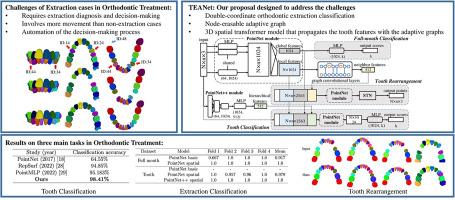TEANet:基于齿级图空间变换网络的自动牙齿提取和排列
IF 4.8
2区 医学
Q1 COMPUTER SCIENCE, INTERDISCIPLINARY APPLICATIONS
引用次数: 0
摘要
背景与目的正畸治疗是一个通过基于网格的分析和牙齿的刚性变形来实现拔牙和排列的过程。目的是实现颅结构与咬合在生理和美学上的平衡关系。现有的自动化治疗计划方法利用点云进行三维分析,利用图卷积网络(GCN)进行特征传播。然而,这些技术是专门为不需要拔牙的病例设计的,因此对于需要拔牙的牙列拥挤病例的准确性有限。方法针对这些挑战,我们提出了拔牙;安排网络(TEANet),一种自动治疗计划方法,可以安排牙齿,包括需要拔牙的病例。我们引入了一种新颖的双坐标牙齿提取分类器和一种自适应排列图。该方法的贡献如下:(1)引入了一种包含多个牙齿子集的全口点云正畸拔牙分类方法;(2)设计了一个节点可擦除的自适应图来表示齿(节点)之间的相互作用(边),用于GCN中的特征传播;(3)引入基于学习的三维空间变压器模型,并结合GCN进行拔牙规划。结果对304例临床病例进行正畸治疗的牙齿分类、拔牙分类和牙齿排列回归三项任务的评价。我们的方法比最先进的方法具有一致性和更好的性能。该数据集将在出版后发布。结论teanet为正畸治疗计划提供了一个新颖而有力的框架,特别是在需要拔牙的情况下。通过利用双坐标分类器、自适应图和基于GCN的学习空间转换器,TEANet超越了现有方法,为处理复杂的正畸病例提供了有效的解决方案。本文章由计算机程序翻译,如有差异,请以英文原文为准。

TEANet: Automated tooth extraction and arrangement with tooth-level graph spatial transformation network
Background and objective
Orthodontic treatment is a process that involves tooth extraction and arrangement achieved via mesh-based analysis and rigid deformation of teeth. The aim is to achieve balanced relationship in physiologic and aesthetic harmony among cranial structures and occlusion. Existing automated treatment planning methods elaborated point cloud for 3D analysis and utilized Graph Convolutional Network (GCN) for feature propagation. However, these techniques were designed specifically for cases not requiring extraction therefore have limited accuracy for dentition crowding cases that require tooth extraction.
Methods
Motivated by these challenges, we propose Tooth Extraction & Arrangement Network (TEANet), an automated treatment planning method that enables tooth arrangement including cases requiring tooth extraction. The novelty we introduce is a double-coordinate classifier for tooth extraction and an adaptive graph for tooth arrangement. Our method makes the following contributions: (1) We introduce an orthodontic extraction classification for full-mouth point cloud that includes multiple tooth subsets; (2) We design a node-erasable adaptive graph to represent interactions (edges) among teeth (nodes) for feature propagation in GCN; and (3) We introduce a learning-based 3D spatial transformer model with GCN to produce tooth arrangement planning for extraction cases.
Results
We evaluated our method on three tasks in orthodontic treatment (tooth classification, extraction classification and tooth arrangement regression) with a total of 304 clinical cases. Our method achieved consistent and better performance than the state-of-the-art methods. The dataset will be released upon publication.
Conclusion
TEANet offers a novel and robust framework for orthodontic treatment planning, particularly in cases that require tooth extraction. By leveraging a double-coordinate classifier, an adaptive graph, and a learning-based spatial transformer with GCN, TEANet outperforms existing methods and provides an efficient solution for handling complex orthodontic cases.
求助全文
通过发布文献求助,成功后即可免费获取论文全文。
去求助
来源期刊

Computer methods and programs in biomedicine
工程技术-工程:生物医学
CiteScore
12.30
自引率
6.60%
发文量
601
审稿时长
135 days
期刊介绍:
To encourage the development of formal computing methods, and their application in biomedical research and medical practice, by illustration of fundamental principles in biomedical informatics research; to stimulate basic research into application software design; to report the state of research of biomedical information processing projects; to report new computer methodologies applied in biomedical areas; the eventual distribution of demonstrable software to avoid duplication of effort; to provide a forum for discussion and improvement of existing software; to optimize contact between national organizations and regional user groups by promoting an international exchange of information on formal methods, standards and software in biomedicine.
Computer Methods and Programs in Biomedicine covers computing methodology and software systems derived from computing science for implementation in all aspects of biomedical research and medical practice. It is designed to serve: biochemists; biologists; geneticists; immunologists; neuroscientists; pharmacologists; toxicologists; clinicians; epidemiologists; psychiatrists; psychologists; cardiologists; chemists; (radio)physicists; computer scientists; programmers and systems analysts; biomedical, clinical, electrical and other engineers; teachers of medical informatics and users of educational software.
 求助内容:
求助内容: 应助结果提醒方式:
应助结果提醒方式:


